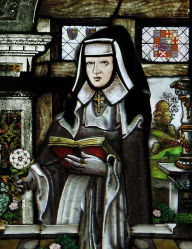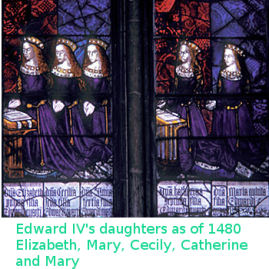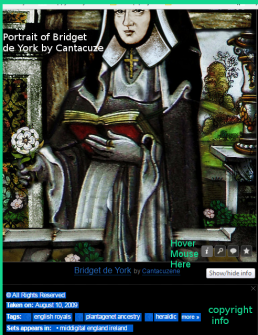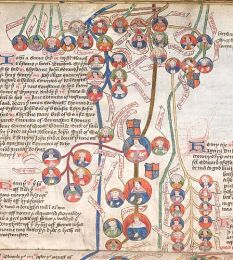Or Why You Should Cite The Source of Images
This post has been prompted by the appearance of portrait of Bridget of York across a variety of Social Media platforms recently. The growth of social media, has widened access to history for many of us but inexperience and lack of knowledge mean that images can easily be shared without acknowledging the source. This potentially creates misinformation and can lead to problems with breach of copyright. The aim of the post is to create a case study and tutorial that illustrates the importance of citing image sources, so that historical discussion and research remains accurate, adds value,and recognises the artist, photographer or other copyright holder.

INITIAL RESEARCH – IS THIS IMAGE WHAT IT CLAIMS TO BE?
Observation of comments across a variety of social media platforms suggest that this is thought to be
“a medieval stained glass window, of Princess Bridget of York from possibly Dartford Priory.”
However there were things that didn’t seem quite right about the image and its attribution, so I began some preliminary research:
Who Was Bridget of York?
The youngest daughter of Edward IV and Elizabeth Wydvil, Bridget became a Dominican nun at Dartford Priory in 1492 and remained there until her death in 1517. (Wikipedia).
A Google search for “medieval nuns stained glass” produced some images but they seemed to suggest that as Bridget was not an abbess, saint or anchoress, it would be unlikely to find her depicted in a window.
Where was the “Photo of the Window” Taken?
A Google image search for “Bridget of York, stained glass England” came up with this image and nothing else. The image was mainly linked to Pinterest pages with no sources given.
A Google search for Dartford Priory, the suggested location, revealed another problem. The priory was dissolved in 1559 and demolished, the site is now a shopping centre (Dartford Town Archive).

Royal Window, Canterbury Cathedral (c) Cambridge Archaeological Society 2015
I was aware of another window that shows Edward IV and family so the search was modified to “stained glass windows daughters of Edward IV”. This is the Royal Window at Canterbury Cathedral, and depicts the York Princesses, except for Bridget. She was born in November 1480, and the window is thought to have been installed earlier that year.
What Do We Now Know?
Essentially very little, we have
“an image of unknown age, of a woman, said to be Bridget of York, in the style of medieval stained glass, made by an unknown artist, at an unknown time, in an unknown place.”
This leaves anyone sharing the image at risk of both perpetuating the stories growing up around it and breaching copyright, which potentially have serious consequences, (See Footnotes). Sharing the image responsibly, would require a little research to identify its age, original source and if relevant the photographer.
IDENTIFYING THE SOURCE OF AN IMAGE
This process has been developed by trial and error and I’m always open to suggestions on how to improve and hopefully speed up my searches.
1. Ask People Who Might Know – Save Your Fingers Some Work!
I fortunately have very helpful Facebook friends who are historians and art historians (see acknowledgements), so initially I posted the image on my timeline and gathered opinions, information and suggestions of sites to search, plus further histories of Dartford Priory and Bridget’s life and verification of my suspicions about the age of the image. I then used Google as a research tool as follows:
2. Google Reverse Image Search
This can be done on mobile phones and tablets as well a pc or laptop.
-
Open Google and search using “Bridget of York Stained Glass”
-
Select the images tab
-
Click on the image you want to open – the one of “our window”
-
Right click on the image and select “search for this image on Google”
-
Google will then bring up a list of sites, including that of the original artist, displaying the image – the site is called “Flickriver”.
RESULTS AND ACTIONS TAKEN
A simple search discovered that the “medieval window” was actually painted by Cantacuze in 2009 as part of a series of paintings of Plantagenet woman.
Adding The Copyright Details to Posts
 Now we have the source of the image, we need to find the following information: artists name, a date and the correct title for the image. Some sites do make this harder to find than others, which is where the problem with our painting of Bridget, might have arisen.
Now we have the source of the image, we need to find the following information: artists name, a date and the correct title for the image. Some sites do make this harder to find than others, which is where the problem with our painting of Bridget, might have arisen.
Finding Source Information on Flickriver:
-
Hover your mouse over the bottom right of the portrait,
-
Click on the ‘i’ icon that appears in the bottom right of the image, as per the diagram posted on the left
-
Each time you post the image, credit it as follows:
Image Title, Creator’s Name (c) Date e.g. Bridget de York by Cantacuze (c) 2009.
IS THERE A PORTRAIT OF BRIDGET FROM HER LIFETIME?

Bridget’s wikipedia entry, had an illustration, from a manuscript in the British Library but the link was broken. I eventually found it within a manuscript listed as “Kings 395” and described as a “Biblical and genealogical chronicle from Adam and Eve to Edward VI (the Longer English genealogical chronicle of the kings of England). However it is dated C 1511 with later additions before 1553. The text of the chronicle ends with Richard III on f33, but the dynastic tree on f32v contains rough sketches of Edward IV, Elizabeth Wydvil and their family, but due to the date its unlikely that the scribe saw Bridget in life.
FOOTNOTES
1. Image search with Tineye – upload an image or give the URL or internet address of the image. If you want to know the URL, right click on the image and select “copy image address. Paste this into the search box on tineye and it does all the work for you. It can be installed as a browser add or used via the website https://www.tineye.com/.
2. Copyright
All images online belong to someone, be it the artist, photographer or in some instances both.
Failure to cite a source lead to anything from an easily fixed problem to an expensive legal process.
For example I share portrait of Bridget on Pinterest board and write about her on my blog but fail to share the source “Bert Bloggs Artist” emails me and askis me to either credit him or remove the image. I add “Original artwork (c) Bert Bloggs 2016, the problem is resolved. But I’m a crafter and I love the image so much I design and start selling cross stitch kits based on the image, without consulting or crediting “Bert”. He’d consult the lawyers and I’d end up with a bad reputation, huge bill and a lot of unsaleable kits.
3. Copyright, Manuscripts and Artefacts
Copyright is slightly different here, for example copyright doesn’t apply to a medieval manuscript or work of art but there are 2 things to be aware of:
Images made from medieval originals, are still subject to copyright as the image is owned by the person or organisation who made it. The British Library has an excellent guide for the use of their scanned manuscripts, which are shared under a creative commons licence: http://www.bl.uk/catalogues/illuminatedmanuscripts/reuse.asp.
But if I upload my photo of Romsey Abbey’s Saxon Rood to social media, the copyright is mine, as I took the photo. So if sharing images in groups, always ask the original poster if they are happy for you to share and credit them.
4. Collections of manuscripts, artworks and artifacts, whether in libraries, universities, museums or private collections will also be governed by various policies and you should ensure you abide by them before downloading images or making your own.
Acknowledgements
I would like to thank, Jennifer Gentle, Heather Millard, Sophia Connor, Elizabeth Hopkins, Natasha Coombs and Ann Victoria Roberts for their kindness in sharing information, expertise and providing advice and opinions on the painting that prompted this post. It certainly saved me a bit of time and a few grey hairs when searching for the information I needed in order to compile it.
References And Bibliography
Cantacuzene (c2009) Plantagenet Ancestry [online] http://www.flickriver.com/photos/tags/plantagenetancestry/interesting/ Accessed 28.12.16
Canterbury History and Archaeological Society (2015) Royal Window, Edward IV [online] http://www.canterbury-archaeology.org.uk/royal/4590809716 accessed 29.12.16
Dartford Town Archive (undated) Dartford Priory [online] http://www.dartfordarchive.org.uk/medieval/religion_pr.shtml Accessed 28.12.16
Kings 395 (1511-53) British Library Detailed Record for Kings 395 [online] accessed 28.12.16 http://www.bl.uk/catalogues/illuminatedmanuscripts/record.asp?MSID=3014&CollID=19&Nstart395
Wikipedia (2016 modified) Bridget of York [online] https://en.wikipedia.org/wiki/Bridget_of_York Accessed 28.12.16
Although I am not a trained historian, I AM a trained researcher. Thank you for pursuing the origin of the picture of Bridget, and describing why it is important to cite sources. Too much misinformation gets repeated as fact, then it is difficult to “un-do” it.
LikeLike
Thank you Marilyn, I’m not a trained historian either but have a background in health and social sciences. I just rediscovered a passion for history a couple of years ago. And like you I find un-doing wrongly attributed information is much harder than trying to get to the source 🙂
LikeLike
Thanks for bringing the intellectual rigor. I follow some historical pages on Facebook, where some of the posters are historians, but many more are enthusiasts–not that there is anything wrong with that! With the current concerns about “fake news,” I hope we see more care with citations generally.
LikeLike
May I share this on the British Medieval History Facebook page?
LikeLike
Hi Roxane thank you for your kind feedback. Yes I’m very happy for you to share. Thanks Bev
LikeLike
Great advice – I’d seen this on the British Medieval History group facebook page and saved the post. Thanks
LikeLike
Thank you so much for your lovely feedback 😊
LikeLike